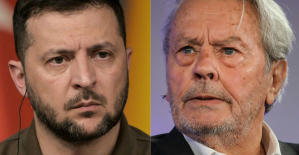in the Autumn of 1994 draws the author Iain Sinclair a large V on the Londonkartan. During the few days following he line and make a note of what he sees along the urban stratigrafin; roman columns, graffiti, ärgade churches, pubs, bums, and printers, viaducts, posters and voodoobutiker, cemeteries, railroad tracks and the rusty viktorianism.
the Walk launches the book ”Lights out for the territory. 9 excursions in the secret history of London” published in 1997. Sinclair had previously made herself for the prosapoetiska ”Lud heat” (1975), where he revived the strange amateur archaeologist Alfred Watkins theories from the 1920s that the British isles is crossed by the so-called ley-lines stemming from the misty uråldern. Sinclair applied the lines on the Londonkartan, more specifically, on the basis of the many churches designed by architect Nicholas Hawksmoor.
the Result was a feverish, visionary, mystical reinterpretation of the capital's map. ”Lud heat” inspired the later presented by comic artist, now the magician, Alan Moore for his graphic masterpiece about the Whitechapel-murders ”From Hell”.
books are the now 75-year-old Iain Sinclair to be the foremost representative of what is called psykogeografi.
My word processing program yelling angrily red as I write this.
Psykogeografi.
But it is a literary and artistic practice derived from Londonströvare as Defoe, william Blake and London and Parisflanörer as Baudelaire, Walter Benjamin, and the French surrealists. The following was used psykogeografin as a subversive political strategy of the French situationister, thus, to modern practitioners such as English Sinclair, Peter Ackroyd and Will Self. Yes, it is a very male tradition, despite the fact that it would not need to be there.
Psykogeografin is an attempt to create a four-dimensional map of a (urban)landscape. The idea is that all the past all the layers leave mental traces even in what we call our time. The author's method lets archives, shank, science, and urban planning meet halvlegal urban exploration, dokumentärfotografisk transcript, anecdotes, footwork, and ghosts. London and Paris are, not surprisingly, absolute centres for the practice. This rises glasskrapor on top of the ruins of the mental hospital, on top of the medieval crypts, the top of the roman mithrastempel, and inserted are the poets, vetenskaparna, the artists, the ows, the maniacs, the decisions.
”Under the sidewalks – the beach”, as a situationistisk slogan was in 1968 Pariskravaller.
political. Iain Sinclair has been known as a furiös critics of Thatchereran and everything similar that came after. When he published a thick examination of its own town which was also a venomous protest against the construction of the new OLYMPIC stadium (”Hackney, That rose-red empire: A confidential report”, in 2009, he was vented by booksellers and libraries after the political pressure.
His equally famous colleague, Peter Ackroyd is inclined, however, more to the aristocratic conservative direction, and dream themselves back to the vaguely mythical times.
I am looking for a Swedish example, the Swedish psykogeografer, but find only weak shadows of the genre. Possibly bothered by a Swedish author wind a modern-day portrayal with any previous era, but more than two or three layers seem to be overwhelming.
what would happened if a Ernst Brunner had tried on the psykogeografiska envelope in some of his later books. Instead of certainly excellent, but a bit dry, descriptive biographies of the people, as Swedenborg, gustav iii, and Johan Helmich Roman – why not use all this research, blast the historical and mental layers and to capture the pieces in the air. Juggle with them, with a flanerande and enthusiastic interpretive I like contemporary but time traveling medobservatör.
He and several other authors with the potential (Per Johansson, Nina Burton, Carina Burman, Jerker Virdborg, Kristian Petri, Klas Östergren, Therése Söderlind?) maybe you should study three Swedish authors who actually achieved something approaching psykogeografi.
Per Wirténs ”Where I come from ” (2010) mixes personal memory with the critical analysis of urban history. With walking binds together the theme of the Heron city to Englewood.
as in ”Visit Norrtuna” (2010) strolling in his childhood suburb of Järna and in a full fledged way delves in the personal and in the relatively brief but surprisingly rich lokalhistorien.
And it is Peter Bryngelsson ”What lurks not in Älmeboda” (2018), where the first author takes on the local stories, time-review", the myths and byaskvallret flowing ”quite homeless around in the area that lost flocks”. The small village in Tingsryd municipality turns out to house an immense wealth of flocks.
It is hard to see why Stockholm, Gothenburg, Malmö or Uppsala would be worse equipped than Norrtuna and Älmeboda as a material for a psykogeografisk survey. Rather, it is up to the authors.
Essay: So was the walk, a protest against the modern.

 Sydney: Assyrian bishop stabbed, conservative TikToker outspoken on Islam
Sydney: Assyrian bishop stabbed, conservative TikToker outspoken on Islam Torrential rains in Dubai: “The event is so intense that we cannot find analogues in our databases”
Torrential rains in Dubai: “The event is so intense that we cannot find analogues in our databases” Rishi Sunak wants a tobacco-free UK
Rishi Sunak wants a tobacco-free UK In Africa, the number of millionaires will boom over the next ten years
In Africa, the number of millionaires will boom over the next ten years Can relaxation, sophrology and meditation help with insomnia?
Can relaxation, sophrology and meditation help with insomnia? WHO concerned about spread of H5N1 avian flu to new species, including humans
WHO concerned about spread of H5N1 avian flu to new species, including humans New generation mosquito nets prove much more effective against malaria
New generation mosquito nets prove much more effective against malaria Covid-19: everything you need to know about the new vaccination campaign which is starting
Covid-19: everything you need to know about the new vaccination campaign which is starting For the Olympics, SNCF is developing an instant translation application
For the Olympics, SNCF is developing an instant translation application La Poste deploys mobile post office trucks in 5 rural departments
La Poste deploys mobile post office trucks in 5 rural departments Meta accelerates into generative artificial intelligence with Llama 3
Meta accelerates into generative artificial intelligence with Llama 3 In China, Apple forced to withdraw WhatsApp and Threads applications at the request of the authorities
In China, Apple forced to withdraw WhatsApp and Threads applications at the request of the authorities The main facade of the old Copenhagen Stock Exchange collapsed, two days after the fire started
The main facade of the old Copenhagen Stock Exchange collapsed, two days after the fire started Alain Delon decorated by Ukraine for his support in the conflict against Russia
Alain Delon decorated by Ukraine for his support in the conflict against Russia Who’s Who launches the first edition of its literary prize
Who’s Who launches the first edition of its literary prize Sylvain Amic appointed to the Musée d’Orsay to replace Christophe Leribault
Sylvain Amic appointed to the Musée d’Orsay to replace Christophe Leribault Skoda Kodiaq 2024: a 'beast' plug-in hybrid SUV
Skoda Kodiaq 2024: a 'beast' plug-in hybrid SUV Tesla launches a new Model Y with 600 km of autonomy at a "more accessible price"
Tesla launches a new Model Y with 600 km of autonomy at a "more accessible price" The 10 best-selling cars in March 2024 in Spain: sales fall due to Easter
The 10 best-selling cars in March 2024 in Spain: sales fall due to Easter A private jet company buys more than 100 flying cars
A private jet company buys more than 100 flying cars This is how housing prices have changed in Spain in the last decade
This is how housing prices have changed in Spain in the last decade The home mortgage firm drops 10% in January and interest soars to 3.46%
The home mortgage firm drops 10% in January and interest soars to 3.46% The jewel of the Rocío de Nagüeles urbanization: a dream villa in Marbella
The jewel of the Rocío de Nagüeles urbanization: a dream villa in Marbella Rental prices grow by 7.3% in February: where does it go up and where does it go down?
Rental prices grow by 7.3% in February: where does it go up and where does it go down? With the promise of a “real burst of authority”, Gabriel Attal provokes the ire of the opposition
With the promise of a “real burst of authority”, Gabriel Attal provokes the ire of the opposition Europeans: the schedule of debates to follow between now and June 9
Europeans: the schedule of debates to follow between now and June 9 Europeans: “In France, there is a left and there is a right,” assures Bellamy
Europeans: “In France, there is a left and there is a right,” assures Bellamy During the night of the economy, the right points out the budgetary flaws of the macronie
During the night of the economy, the right points out the budgetary flaws of the macronie These French cities that will boycott the World Cup in Qatar
These French cities that will boycott the World Cup in Qatar Europa League: “We dream of everything,” says Jean-Louis Gasset
Europa League: “We dream of everything,” says Jean-Louis Gasset Europa League: “Trouble playing our football,” admits Benfica coach
Europa League: “Trouble playing our football,” admits Benfica coach Europa League Conference: “Martinez eats all your deaths”, Obraniak’s breakdown after the elimination of Lille
Europa League Conference: “Martinez eats all your deaths”, Obraniak’s breakdown after the elimination of Lille Premier League: “It’s a team that is transforming into the Champions League”, Casemiro returned to Real’s qualification
Premier League: “It’s a team that is transforming into the Champions League”, Casemiro returned to Real’s qualification


















